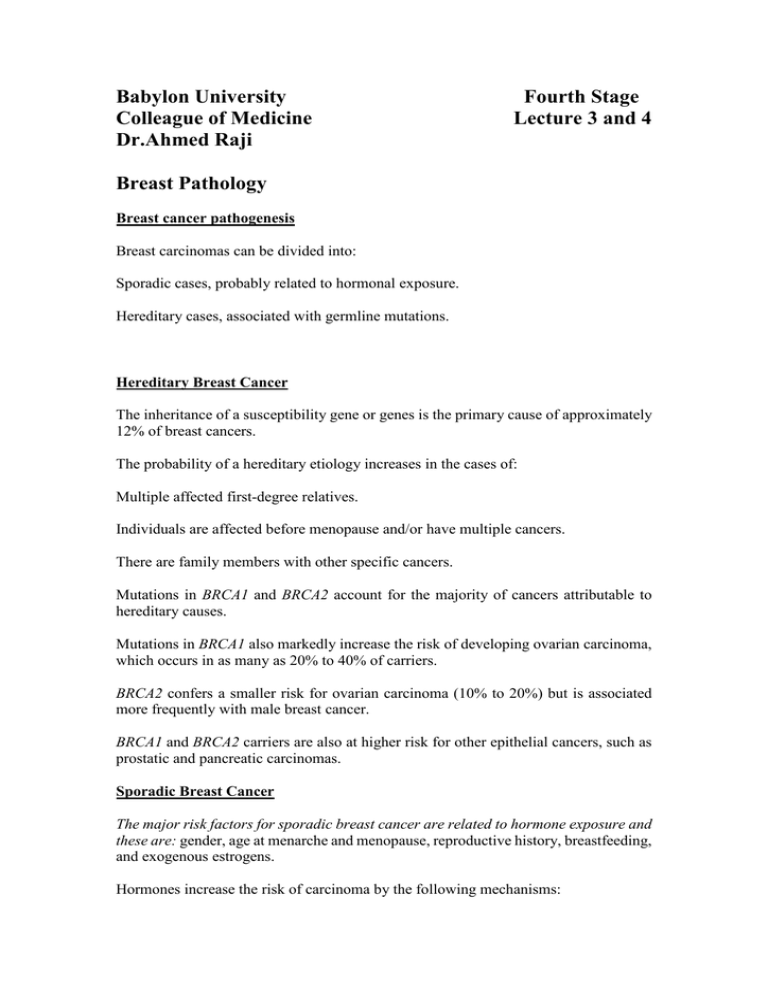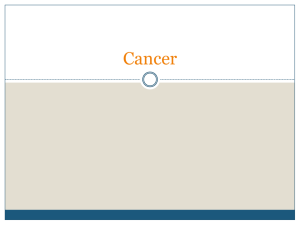Babylon University ... Colleague of Medicine ...
advertisement

Babylon University Colleague of Medicine Dr.Ahmed Raji Fourth Stage Lecture 3 and 4 Breast Pathology Breast cancer pathogenesis Breast carcinomas can be divided into: Sporadic cases, probably related to hormonal exposure. Hereditary cases, associated with germline mutations. Hereditary Breast Cancer The inheritance of a susceptibility gene or genes is the primary cause of approximately 12% of breast cancers. The probability of a hereditary etiology increases in the cases of: Multiple affected first-degree relatives. Individuals are affected before menopause and/or have multiple cancers. There are family members with other specific cancers. Mutations in BRCA1 and BRCA2 account for the majority of cancers attributable to hereditary causes. Mutations in BRCA1 also markedly increase the risk of developing ovarian carcinoma, which occurs in as many as 20% to 40% of carriers. BRCA2 confers a smaller risk for ovarian carcinoma (10% to 20%) but is associated more frequently with male breast cancer. BRCA1 and BRCA2 carriers are also at higher risk for other epithelial cancers, such as prostatic and pancreatic carcinomas. Sporadic Breast Cancer The major risk factors for sporadic breast cancer are related to hormone exposure and these are: gender, age at menarche and menopause, reproductive history, breastfeeding, and exogenous estrogens. Hormones increase the risk of carcinoma by the following mechanisms: 1 - Hormonal exposure increases the number of breast epithelial cells by stimulating breast growth during puberty, menstrual cycles, and pregnancy. 2 - Exposure also drives cycles of proliferation that place cells at risk for DNA damage. 3 - Once premalignant or malignant cells are present, hormones can stimulate their growth, as well as the growth of normal epithelial and stromal cells that may aid and abet tumor development. Overview of Carcinogenesis and Tumor Progression A normal cell must acquire several new mutations to become malignant Firstly populations of cells acquire some, but not all, of the genetic changes of carcinogenesis giving rise to breast lesions that are associated with an increased risk of progression to cancer (example : proliferative breast diseases , atypical hyperplasia, carcinoma in situ)). Then the transition of carcinoma in situ to invasive carcinoma depend on a complex interplay between luminal cells, myoepithelial cells, and stromal cells. Classification of Breast Carcinoma Greater than 95% of breast malignancies are adenocarcinomas, which are divided into 1 - CARCINOMA IN SITU Ductal carcinoma in situ Lobular carcinoma in situ 2 - INVASIVE CARCINOMA No-special-type carcinoma (ductal) Lobular carcinoma Tubular/cribriform carcinoma Mucinous (colloid) carcinoma Medullary carcinoma Papillary carcinoma Metaplastic carcinoma Carcinoma in situ refers to a neoplastic proliferation that is limited to ducts and lobules by the basement membrane. Invasive carcinoma has penetrated through the basement membrane into stroma, and invade into the vasculature and thereby reach regional lymph nodes and distant sites. Diagnosis of breast carcinoma 1- History 2-Examination 3-Investigation: A-Radiological (mammography, ultrasound) B-Lab 1- FNA. 2-True cut biopsy. 3-Incisional biopsy. 4-Excisinal biopsy. 5-Immunohistochemistry 6-Genetics Carcinoma in Situ Ductal Carcinoma in Situ (DCIS) DCIS consists of a malignant population of cells limited to ducts and lobules by the basement membrane. The myoepithelial cells are preserved. Most are detected as a result of calcifications; less commonly, as a mammographic density or a vaguely palpable mass. Rarely, DCIS produces a nipple discharge or is detected as an incidental finding upon biopsy for another lesion. DCIS has been divided into five architectural subtypes: 1 - Comedocarcinoma 2 - Solid 3 - Cribriform 4 - Papillary 5 - Micropapillary. All women with DCIS were treated with mastectomy, usually followed by radiation. If untreated, women with small, low-grade DCIS develop invasive cancer at a rate of about 1% per year. Lobular Carcinoma in Situ (LCIS) LCIS is always an incidental biopsy finding, since it is not associated with calcifications nor produce mammographic densities. LCIS is more common in young women, with 80% to 90% of cases occurring before menopause. LCIS consist of dyscohesive cells with oval or round nuclei and small nucleoli, the cells lack the cell adhesion protein E-cadherin, resulting in the cells appearing rounded without attachment to adjacent cells. Women with LCIS develop invasive carcinomas at a frequency similar to that of women with untreated DCIS, treatment choices include bilateral prophylactic mastectomy, or, close clinical follow-up and mammographic screening. Invasive (Infiltrating) Carcinoma Clinically Invasive carcinoma almost always presents as a palpable mass that may be fixed to the chest wall or cause dimpling of the skin. Retraction of the nipple may develop. Thickening and tethering of the skin to the breast mimics the appearance of an orange peel, an appearance referred to as peau d'orange. The term inflammatory carcinoma is reserved for tumors that present with a swollen, erythematous breast, this gross appearance is caused by extensive invasion and obstruction of dermal lymphatics by tumor cells. Paget disease of the nipple is a rare manifestation of breast cancer (1% to 4% of cases) and presents as a unilateral erythematous eruption with a scale crust. Pruritus is common, and the lesion may be mistaken for eczema. A palpable mass is present in 50% to 60% of women with Paget disease, and almost all of these women have an underlying invasive carcinoma. In contrast, the majority of women without a palpable mass have only DCIS. The carcinomas are usually poorly differentiated, ER negative, and overexpress HER2/neu. Rarely, breast cancer presents as an axillary nodal metastasis or distant metastasis before cancer is detected in the breast. Invasive Carcinoma, No Special Type (NST; Invasive Ductal Carcinoma) Invasive carcinomas of no special type include the majority of carcinomas (70% to 80%). Morphology. Grossly Most tumors are firm to hard and have an irregular border, when cut they typically produce a characteristic grating sound. Microscopically Well-differentiated carcinomas show prominent tubule formation, small round nuclei, and rare mitotic figures Moderately differentiated carcinomas may have tubules, but solid clusters or single infiltrating cells are also present. These tumors have a greater degree of nuclear pleomorphism and contain mitotic figures. Poorly differentiated carcinomas often invade as nests or solid sheets of cells with enlarged irregular nuclei. A high proliferation rate and areas of tumor necrosis are common. Invasive Lobular Carcinoma Invasive lobular carcinomas usually present as a palpable mass or a mammographic density with irregular borders. Lobular carcinomas have been reported to have a greater incidence of bilaterality. The actual fraction of women who develop invasive carcinomas in the contralateral breast is only 5% to 10%. Morphology. Microscopically The histologic hallmark is the presence of dyscohesive infiltrating tumor cells, often arranged in single file or in loose clusters or sheets, tubule formation is absent. Signetring cells containing an intracytoplasmic mucin droplet are common. Desmoplasia may be minimal or absent. Lobular carcinomas have a different pattern of metastasis than other breast cancers. Metastasis tends to occur to the peritoneum and retroperitoneum, the leptomeninges (carcinoma meningitis), the gastrointestinal tract, and the ovaries and uterus. Immunohistochemistry Estrogen and progesterone receptors (ER, PR). These are nuclear hormone receptors, and represent an important predictor of response to hormonal therapy, 80 % of carcinomas that are ER and PR positive respond to hormonal manipulation, whereas only about 40% of those with either ER or PR alone respond. ER-positive cancers are less likely to respond to chemotherapy. Conversely, cancers that fail to express either ER or PR have a less than 10% likelihood of responding to hormonal therapy but are more likely to respond to chemotherapy . HER2/neu. HER2/neu is a transmembrane receptor, its overexpression is associated with poorer survival, but its main importance is as a predictor of response to certain drugs like: (Herceptin). Genetic study: Recently developed techniques that examine the DNA, RNA, and proteins of carcinomas have provided new molecular classifications of breast cancers. Gene expression profiling has identified four major patterns of gene expression in the ductal carcinoma group: luminal A, luminal B, basal-like, and HER2 positive. These molecular classes correlate with prognosis and response to therapy, and thus have taken on clinical importance. • “Luminal A” (40% to 55% of NST cancers): This is the largest group and consists of cancers that are ER positive and HER2/neu negative. The majority are well- or moderately differentiated, and most occur in postmenopausal women, these cancers are generally slow growing and respond well to hormonal treatments. • “Luminal B” • “Basal-like” • “HER2 positive” Prognostic and Predictive Factors The outcome for women with breast cancer varies widely. Many women have a normal life expectancy, whereas others have only a 10% chance of being alive in 5 years. The major prognostic factors are as follows: 1. Invasive carcinoma versus in situ disease. 2. Distant metastases. 3. Lymph node metastases 4. Tumor size. 5. Locally advanced disease. 6. Inflammatory carcinoma. Minor Prognostic and Predictive Factors • Histologic subtype. • Histologic grade. • Estrogen and progesterone receptors. • HER2/neu. • Lymphovascular invasion. • Proliferative rate. • DNA content. • Response to neoadjuvant therapy.







